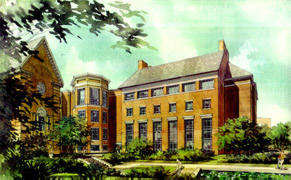|
La Guardia Hall was part of the original configuration of five Georgian-style structures completed in 1937. The others were Boylan, Ingersoll, and Roosevelt Halls and the heating plant. 
In 1959 an addition, sometimes referred to as new La Guardia, later named Gideonse Library, was built onto La Guardia Hall and the library moved into that space. Old La Guardia was then used for various purposes. During the 1980s much of the interior of old La Guardia was restored and rooms on the second and fourth floors were returned to the library for its use. By the 1990s it became evident that the library had vastly outgrown its combined space. The Library Project consists of the complete renovation of both the old and new La Guardia buildings plus the construction of an extension onto new La Guardia. The decision to renovate the existing structures rather than to erect a new building elsewhere on campus derives from the master plan's goal of adhering to the original concept of the architect Randolph Evans in 1935, which held that the library should be the focal point of the campus and at the center of the East Quad. 
The library is the first of eighteen projects identified by the master plan to receive funding. Thanks to the Herculean efforts of many, especially President Vernon E. Lattin and former Vice-President for Finance and Administration Patricia Hassett, the project will move forward. The design will cost $8.2 million; the construction, $54.4 million. The critical need for a renovation and an addition was based on three factors: insufficient space for the existing collection and for seating, ongoing environmental damage to the collection, and the limitations of the present building for accommodating the technology required to serve the academic community of the twenty-first century. In short, there is no more room for books, and, as enrollment has grown, the available seating has shrunk to make room for the growing collection. Moreover, the poor ventilation, coupled with two major floods in 1992, has accelerated the disintegration of the materials--the pre-1981 imprints, which are made of acidic paper--and the wiring capacity of the building has reached its limit. The building has become so harmful to the collection and to its occupants that consultants have determined it would cost as much to make essential repairs and replace the deteriorating collection as it will to do new construction. The master plan calls for an increase of 71,700 net assignable square feet (gross square footage includes areas not used by the program, for example, stairwells, rest rooms, and air shafts). The master planners arrived at this figure by using projections to the year 2003 for collection growth and student enrollment and employing established formulae for office, seating, and group study space. The new library will also share space with Information Technology and Services, which will occupy a substantial portion of the fourth floor. This will enable the library building to be the hub of technological endeavors on the campus. The Faculty Lounge will move to a new area on the first floor, east of its present location, in a self-contained space fitted with a separate entrance, kitchenette, and rest room. 
Plans have been under way since November 1995. Programming is now completed and a schematic design is finished. Construction is scheduled to begin in March 1999, and, if all goes according to plan, the new building will be ready in Summer 2001. All stages of the project thus far have proceeded in a similar way. Members of the library staff meet regularly and at length with the building professionals—the space planner, Randall Rice, of the Omni-Group, or architects from Shepley Bulfinch Richardson and Abbott or from Butrick White and Burtis. The staff makes recommendations that are sent to the Steering Committee and to the Executive Committee. The Steering Committee is made up of representatives from the faculty, staff, CUNY, DASNY, and student government. The Executive Committee is composed of college administrators. The committees review the library's recommendations on programmatic issues and other experts' recommendations on mechanical issues in order to make decisions. In April 1996 Randall Rice led a series of meetings with library staff to develop the building program. After a thorough analysis of the current services and determination of which would require expansion or reduction, a building program was developed that takes into account how much space is needed for each library component and the physical relationships among them. One goal of the renovation is to bring similar functions together in order to make better use of existing staff. To this end, Special Collections will move to the first floor and will share staff with Information Services. Government documents, microforms, and journals will be located in adjacent spaces on the lower level. 
Beginning in fall 1996, the Library Cabinet, comprising the heads of each division, met with the architects biweekly. Each meeting was followed by a meeting of the Steering Committee. In this phase, the outer shape of the building emerged. The decision to have one extension rather than two was determined as much by economic realities as by aesthetic principles. Although every attempt will be made to unify the three structures, financial constraints may determine how much can be done to the existing buildings to accomplish this goal. With regard to design, a floor plan has been produced for each of the four levels. True to the master plan, the entrance to the library will be relocated to its original spot on the west side of La Guardia, facing the Quadrangle. The library is firmly committed to maintaining services during the construction phase. Adapted from an article by Judith W. Wild originally published in the Brooklyn College Faculty Newsletter (Fall 1997) |